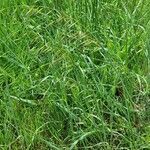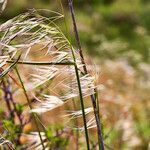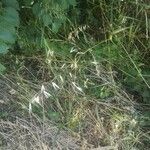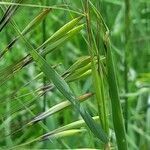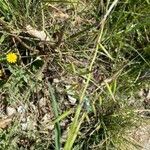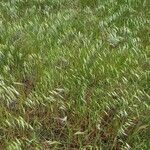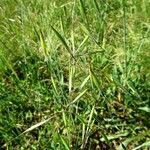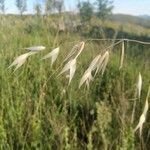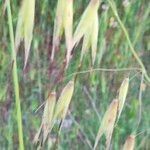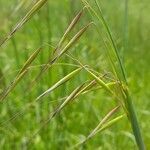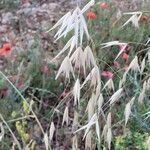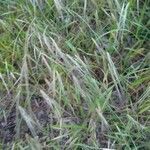Tufts green to dark green, often very slender, 65-100-(170) cm, erect or drooping above in taller plants. Leaf-sheath smooth, or slightly scabrid above, occasionally red-tinged. Ligule 2.7-5-(9) mm, obtuse, denticulate, abaxially finely scabrid. Leaf-blade 12.5-30 cm × 2-8 mm, finely scabrid on ribs and margins. Culm internodes glabrous. Panicle (12)-18-40 cm, very lax, equilateral; rachis smooth, branches and pedicels very filiform, finely scabrid. Spikelets 40-50 mm, 2-(3)-flowered; disarticulation below each floret at maturity. Glumes 7-9-nerved. Lemma 12-18 mm, narrow-lanceolate, light brown, with long stiff reddish hairs below level of awn insertion, green and scabrid above, each lobe-tip produced to a fine bristle (2-3 mm); lemmas awned, awns 30-36 mm, geniculate, column very dark brown, twisted. Palea keels with 1-2 rows of cilia, interkeel glabrous, flanks sometimes sparsely scabrid. Callus long hairy, with horse-shoe shaped scar. Rachilla long hairy. Anthers 2-3 mm. Caryopsis 5-7 × 0.8-1.3 mm, light brown, silky hairy.
Tufted annual, 0.3-1.3 m high; culms solitary. Leaf blade 70-300 x 3-10 mm, soft, expanded; ligule an unfringed membrane. Inflorescence an open panicle. Spikelets 18-26 mm long, laterally compressed; glumes ± equal, as long as to longer than spikelet; lower glume 3-5-veined; upper glume 5-7-veined, lanceolate or elliptical, acute at apex. Florets 2 or 3; lemma hairy in lower half, 5-9-nerved; lobes awned, awns 4-8 mm long; central awn 35-40 mm long, longer than body of lemma, lower part twisted; palea shorter than lemma, hairy on keels; callus present on all lemmas; anther 2.0-3.2 mm long. Variable in plant height and spikelet size, easily distinguished by lemma lobes awned. Flowering time Aug.-Dec.
Tufted annual 300-1300 mm high; culms solitary. Leaf blade 70300 x 3-10 mm, soft and expanded. Spikelet 18-26 mm long, 2 to 3-flowered; lower glume 3-5-veined; upper glume 5-7-veined, lanceolate or elliptical, apex acute; lemma hairy in lower half; lobe awn 4-8 mm long, 1-nerved; central awn 35-40 mm long; palea shorter than lemma, hairy on keels; callus present on all lemmas; anther 2.0-3.2 mm long.
An erect, tufted annual grass. It grows 75 cm high. The sheaths are open to the base. The lower part is hairy. The flowers are in groups of 2 or 3. They are clustered in spikelets and these are grouped in a head up to 30 cm long. The spikelets are 18-30 mm long and drooping.
Like A. byzantina but lemmas densely hairy.
